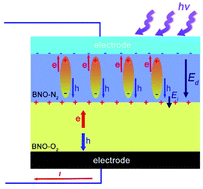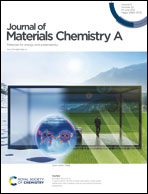Defect engineering for creating and enhancing bulk photovoltaic effect in centrosymmetric materials†
Abstract
The bulk photovoltaic (BPV) effect of conventional ferroelectric (FE) materials has sparked a great deal of interest due to anomalous above-bandgap photovoltage. However, large bandgaps and weak photocurrents remain longstanding challenges for FE PV materials in practical applications. To address these issues, we propose a new defect-engineering strategy and demonstrate it on a narrow bandgap centrosymmetric material, BiNbO4 (BNO): the BPV effect is introduced into BNO by tuning the defect amounts, then a defect-modified homojunction structure is constructed to enhance the BPV effect. This defect engineering strategy enables synergetic effects, e.g., enhanced light absorption, FE-like depolarization field and interfacial polarization. This homojunction structure results in two-fold promotion of photovoltage and ten-fold promotion of photocurrent, compared to the defect-modified BNO sample. We believe this new strategy will break through limitations in traditional material design and pave a novel route to future multifunctional materials, especially high performance BPV materials.



 Please wait while we load your content...
Please wait while we load your content...